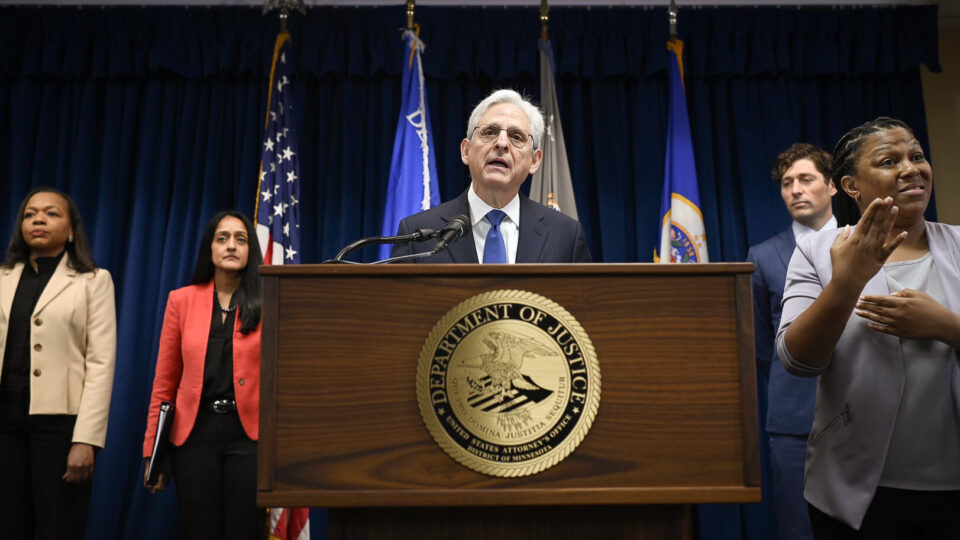Minneapolis Officers Disregarded First Amendment
It Also Took a Good P.R. Team to Lock Up Chauvin
Rachel L. Swarns Wins Award for J-Educator
Ida B. Wells Society ‘Can’t Do Any of Our Work’
L.A. Times, Guild Negotiating 56 Proposed Layoffs
Columnist Says Trump Case Highlights Inequities
Homepage photo: Attorney General Merrick B. Garland announces Friday in Minneapolis that federal investigators found evidence of excessive force and unconstitutional conduct by the Minneapolis Police Department. (Credit: Caroline Yang for The New York Times)
Support Journal-ismsDonations are tax-deductible.
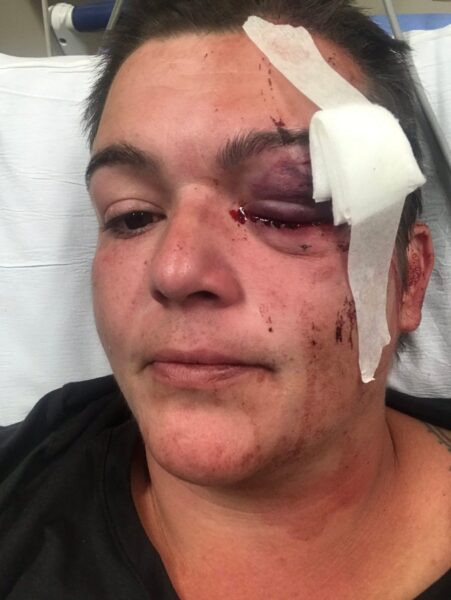
Minneapolis Officers Disregarded First Amendment
The Justice Department’s withering critique Friday of Minneapolis police alleged that officers systematically targeted African Americans and Native Americans, violated constitutional rights and disregarded the safety of people in custody — for years before George Floyd was killed.
Its report also included examples of police mistreatment of the press.
In one of the most severe incidents, freelance writer and photojournalist Linda Tirado was blinded in one eye by a police projectile while covering protests in May 2020. The Minneapolis City Council agreed to a $600,000 settlement, but Tirado, who drove to Minneapolis from Nashville, Tenn., to cover the uproar over Floyd’s murder, said later, “That part of my career was effectively ended May 29, 2020.”
Tirado told the Minnesota Reformer that without depth perception, she uses a walker to get around and finds it difficult to pour coffee in the morning. She also has trouble recalling words.
“I would say there is no way that anyone had looked at me and not known that I am a working journalist,” Tirado told Frances Robles of The New York Times in 2020. “That said, police have been pretty clear that they don’t care if you are working journalist.”
Tirado had donned goggles to protect her eyes. In the commotion of running from tear gas, they slipped off her face, Robles reported.
“ ‘I was aiming my next shot, put my camera down for a second, and then my face exploded,’ she said in a telephone interview after being released from the hospital. ‘I immediately felt blood and was screaming, “I’m press! I’m press!’” ‘
“Ms. Tirado said the shot, which she thought was a rubber bullet, came from the direction of the police. Protesters carried her out, and she had surgery within the hour. Although doctors told her that she is not likely to recover her vision, she is grateful for one thing: she shoots with her right eye.”
Vanita Gupta, associate attorney general; Kristen Clarke, assistant attorney general for civil rights; Amy L. Solomon, acting assistant attorney general for the Office of Justice Programs ; Anthony D. Coley, director, Office of Public Affairs, and senior adviser to the attorney general; Kenneth A. Polite Jr., assistant attorney general for the Criminal Division; and Ronald Davis, director, U.S. Marshals Service, introduced themselves to the Journal-isms Roundtable on Sept. 28, 2021. (Credit: YouTube)
After top Justice Department officials attended the Journal-isms Roundtable by Zoom on Sept. 28, 2021, the department appealed to those with information about police abuse of journalists in three cities to come forward.
“The Civil Rights Division of the U.S. Department of Justice is currently conducting a civil investigation into whether there is reasonable cause to believe that the police departments in Louisville, Kentucky; Minneapolis, Minnesota; and Phoenix, Arizona have engaged in a pattern or practice of civil rights violations,” the statement read.
“Among other things, each investigation is examining the police departments’ handling of protest activities, including police interactions with journalists. If you have information you would like to share about this issue, we encourage you to reach out to the Civil Rights Division’s Special Litigation Section . . . .”
Friday’s report confirmed that the department amassed significant evidence of abuse by the Minneapolis Police Department.
“We found that MPD violates the First Amendment in four ways [PDF]. First, MPD officers retaliate against protesters. Second, MPD officers retaliate against journalists and unlawfully restrict their actions during protests. Third, MPD officers penalize people who challenge or question them during stops and calls for service. Fourth, MPD officers unlawfully interfere with individuals’ right to observe and record police activity,” it said.
In another passage, the report added, “The press has a distinct and essential role in maintaining our democracy. When reporting on government conduct, the press serves as ‘surrogates for the public,’ and their work gathering and sharing information ‘enable[s] speech.’ Accordingly, reporting is a constitutionally protected activity, and the First Amendment prohibits retaliation against individuals for gathering the news.
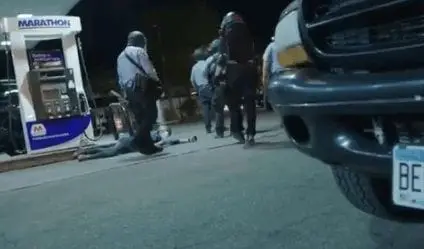
“Regardless, MPD officers regularly retaliate against members of the press — particularly by using force. For example, in October 2020, an MPD sergeant repeatedly pushed a journalist who was actively filming, verbally identified himself as press, and had a press credential around his neck. In the police report, the sergeant falsely claimed that the journalist was leaning against a business owner’s truck and that the sergeant had simply ‘moved the media member off the vehicle.’ Body-worn camera footage clearly shows that the journalist was standing at least a foot away from it.”
Officers “also interfere with newsgathering by unlawfully limiting journalists’ access to public spaces where protests take place, and thus their ability to report on police activity,” the report said.
“The First Amendment requires that any restrictions on when, where, and how reporters gather information ‘leave open ample alternative channels’ for gathering the news. Blanket enforcement of dispersal orders and curfews against press violates this principle because they foreclose the press from reporting about what happens after the
dispersal or curfew is issued, including how police enforce those orders.
“However, MPD regularly enforces general orders to disperse against members of the press. For example, at a 2021 protest, two officers approached a journalist who was standing on a sidewalk recording police and repeating, ‘I’m media! I’m media.’ Both officers told him that he had to leave. One of the officers then said, ‘Time to go!’ and
forcefully shoved the man down the sidewalk.
“During the George Floyd protests in May 2020, Governor Tim Walz imposed an 8 p.m. curfew with an explicit carve-out for press. MPD officers enforced the curfew against the press anyway. In one case, officers approached a group of journalists who identified themselves as press and carried cameras and microphones. An MPD sergeant
screamed at the journalists to ‘fucking go!’ As the journalists packed to leave and tried to open a large gate to exit, two officers pepper sprayed them at close range.”
There was more: “In another case, on May 30, 2020, officers encountered journalists who were sheltering at a gas station. An officer, pointing a 40 mm launcher, approached a journalist who was filming, holding up his press credential, and shouting, ‘I’m press!’ The officer forcefully pushed the journalist’s head to the pavement. As he lay on the ground, the journalist held up his press credential. In response, an MPD sergeant pepper sprayed him directly in his face, then walked away.”
Bruce D. Brown, executive director of the Reporters Committee for Freedom of the Press, said Friday:
“The right of journalists to cover protests is core to the First Amendment, as is the underlying right of the people to protest itself. In its report, the Department of Justice found a disturbing pattern of Minneapolis police officers routinely violating those rights.
“Police departments around the country have an obligation to uphold the First Amendment, and must ensure their own practices are in line with the Constitution.”
Brian O’Hara, the relatively new Minneapolis police chief, said “we will change the narrative around policing in this city” and pledged to work to implement changes called for by the Justice Department.
- J. Patrick Coolican, Minneapolis Reformer: Tirado settlement is an unsatisfactory end to two outrageous incidents in city history (June 2, 2022)
- Editorial, Star Tribune, Minneapolis: U.S. Justice report must lead to police reforms
- Heather Hollingsworth, Associated Press: Takeaways from the scathing report on Minneapolis police after George Floyd’s killing
- Stephen Montemayor and Liz Navratil, Star Tribune, Minneapolis: Justice Department finds pattern of discriminatory policing in Minneapolis

It Also Took a Good P.R. Team to Lock Up Chauvin
The successful prosecution of Derek Chauvin, the former Minneapolis police officer now doing prison time for the murder of George Floyd, was a victory for a media-savvy communications team as well.
That’s according to Minnesota Attorney General Keith Ellison, who led the state’s case against Chauvin, who chronicles the prosecution in his new book, “Break the Wheel: Ending the Cycle of Police Violence.”
Chauvin, who killed Floyd by pinning his neck to the ground for nine minutes and 29 seconds, is serving a 22.5 -year prison sentence. Some of it has been in solitary confinement in a 10-foot-by-10-foot cell.
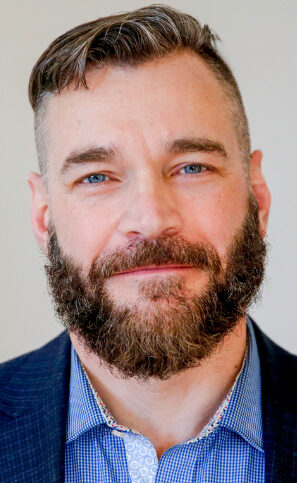 The “media subcommittee was critical to our success,” Ellison wrote. “John Stiles (pictured) led this subcommittee, with help from Keaon Dousti, the AG outreach director. Neal Katyal connected us with a wonderful group of communicators known as the Glover Park Group (GPG). They helped us monitor what the defense counsel were saying, and what social and mainstream media were saying.
The “media subcommittee was critical to our success,” Ellison wrote. “John Stiles (pictured) led this subcommittee, with help from Keaon Dousti, the AG outreach director. Neal Katyal connected us with a wonderful group of communicators known as the Glover Park Group (GPG). They helped us monitor what the defense counsel were saying, and what social and mainstream media were saying.
“Our team simply would have been flying blind without this media awareness, and working with this group gave us a vision of what was out there, whether our narratives were working, how we were doing overall, and how the defense was doing.”
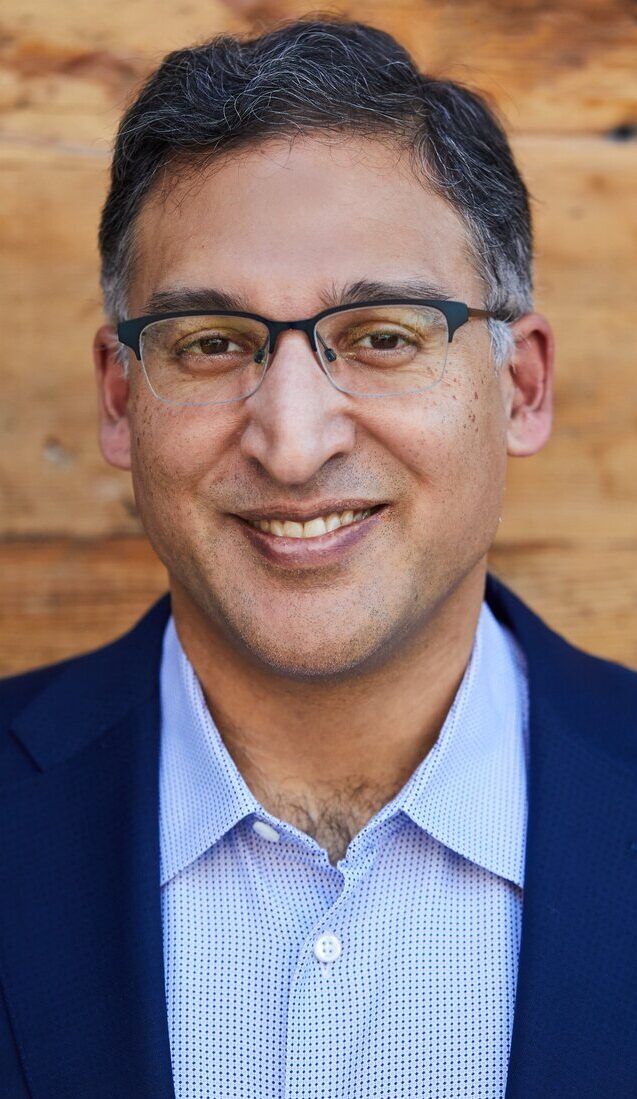 Katyal (pictured), a former acting solicitor general in the Obama administration, is often seen on MSNBC as a legal commentator.
Katyal (pictured), a former acting solicitor general in the Obama administration, is often seen on MSNBC as a legal commentator.
Journal-isms asked Stiles, Ellison’s deputy chief of staff, to elaborate.
“It’s no exaggeration to say that the murder of George Floyd was at one point the biggest news story in the entire world,” Stiles messaged.
“It was simply far beyond the capacity of our one-and-a-half-staff communications group in the Minnesota Attorney General’s Office by ourselves to track and analyze the potential impact of the media coverage on the prosecution, evaluate and prioritize the countless media requests for interviews and information as they came in, and during the Chauvin trial itself, to monitor all the stories for their impact and scan them for any errors that needed to be corrected.
“Attorney General Ellison knew we would need more help, and he was right about that. In addition to my colleague Keaon Dousti from the Attorney General’s Office and me, he assigned to the media subcommittee: former deputy and acting U.S. Solicitor General Neal Katyal, who I’m sure you know is now a seasoned legal commentator on MSNBC and has a very large Twitter following; former federal prosecutor Steve Schleicher, who is a seasoned legal commentator on local television in Minnesota; and a small, tight team of people from the public relations firm FGS Global (which was known at the time as Glover Park Group: after a couple mergers with other firms, they’re now FGS Global).
“Glover Park/FGS were recommended to us by Neal Katyal, and their team of 7 quickly became an integral and trusted part of the media team: they worked for us pro bono, putting in countless hours and keeping their involvement in the prosecution confidential not only from media, the public-relations world, and the public at large, but even from other employees in their company and its successors, because they didn’t want to draw attention to themselves: they only wanted to do what they could to help the prosecution succeed, and effective media monitoring and strategic response was an integral part of that success. “
Stiles was asked how he would evaluate the subcommittee’s effectiveness.
He called it “exceedingly effective. Because of the diversity of experience and perspective of the committee members, the committee collectively made sure that, for example, our public statements were carefully thought through from all angles; that we were prepared to respond effectively and strategically to media questions before and during trial; that we had the full roster of journalists and outlets that were covering the case and trial and ways of communicating with them quickly when needed; and much more.
“Glover Park/FGS also developed a highly effective system of mainstream- and social-media monitoring during the trial: put simply, they were our eyes and ears on the world when the rest of us had to be laser-focused on the courtroom. The magnitude and international significance of the prosecution of George Floyd’s murder simply demanded this depth of organization and sophistication. I cannot overstate the importance of this contribution.”
The public relations industry, in addition to the jury, paid attentiion. “FGS and the Minnesota Attorney General’s Office were honored by the Public Relations Society of America for our work on the Chauvin trial,” Stiles said.
Rachel L. Swarns Wins Award for J-Educator
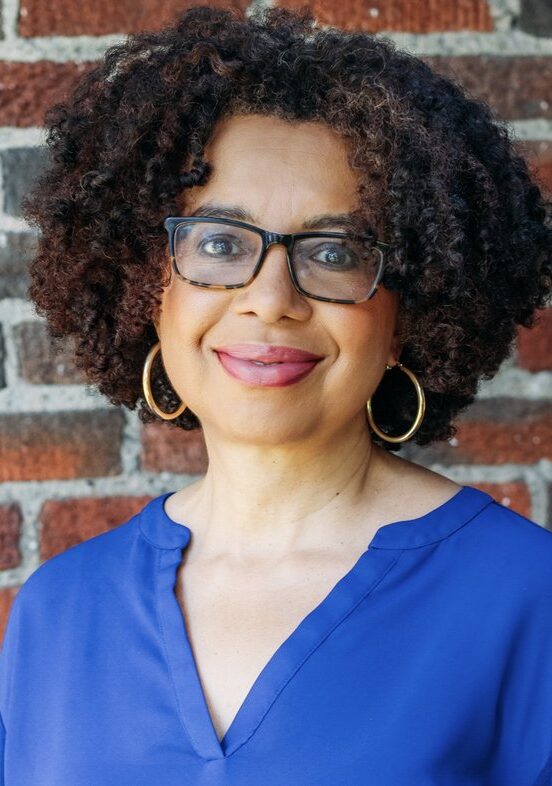 “Rachel L. Swarns, a journalist, author and associate professor of journalism at New York University, is the 2023 recipient of the Barry Bingham Sr. Fellowship, awarded by the News Leaders Association,” the organization announced Tuesday.
“Rachel L. Swarns, a journalist, author and associate professor of journalism at New York University, is the 2023 recipient of the Barry Bingham Sr. Fellowship, awarded by the News Leaders Association,” the organization announced Tuesday.
“The $1,000 award is given in recognition of an educator’s outstanding efforts to encourage students of color in the field of journalism.
“The News Leaders Association empowers journalists at all levels with the training, support and networks they need to lead and transform diverse, sustainable newsrooms.
“The Bingham Fellowship selection committee, led by ‘Journal-isms’ columnist Richard Prince, was impressed by Swarns’ dedication to using journalism to illuminate the nation’s racial history, to setting an example for her students and her actions to support and empower them.
“In nominating Swarns, her former NYU colleague Yvonne Latty, now director of the Logan Center for Urban Investigative Reporting at Temple University, recalled the police murder of George Floyd in 2020 and its aftermath of pain and national introspection. ‘Rachel and I talked almost every day. We were so driven by our pain and the demand of the times to DO SOMETHING.’
” ‘We were constantly working on what we could bring to our students that would help. We held a zoom meeting just for our BIPOC students to vent, we did an event focused on trauma. Rachel led conversations that centered on reporting as a person of color. We raised money and worked hard to engage students. We held each other up when the national rhetoric of hate weakened us. Rachel’s response to hate was always what more can we do. Rachel worked tirelessly to bring anti-racist values and education into our white centered department. . . .’
“Swarns, who spent 22 years as a reporter and correspondent for The New York Times, currently serves as a contributing writer for the paper. Her articles about Georgetown University’s roots in slavery touched off a national conversation about American universities and their ties to this painful period of history. This month, Random House is publishing her ‘The 272: The Families Who Were Enslaved and Sold to Build the American Catholic Church.’ . . . “
- Rachel L. Swarns, Washington Post: The families enslaved by the Jesuits, then sold to save Georgetown (book excerpt)
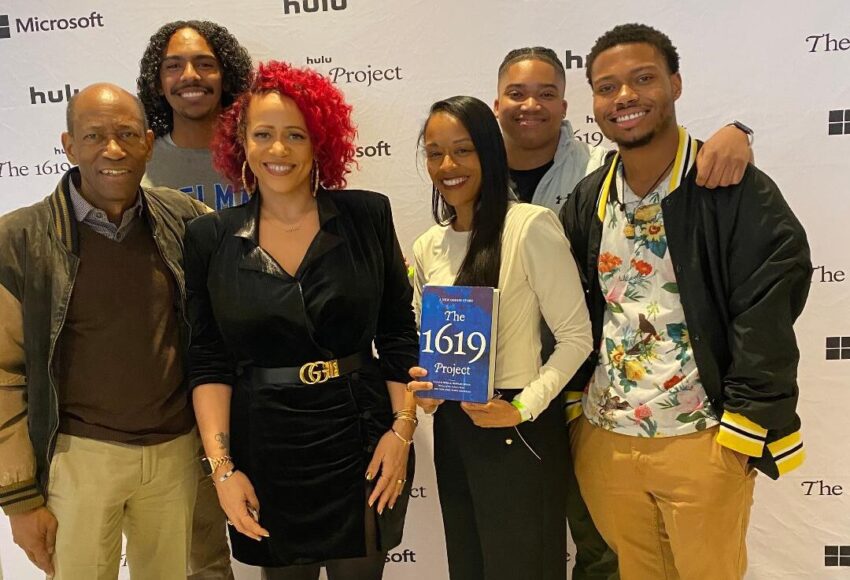
Ida B. Wells Society ‘Can’t Do Any of Our Work’
“Nearly six months after the Ida B. Wells Society for Investigative Reporting notified UNC-Chapel Hill it would be moving to Morehouse College, the university has yet to transfer all of the society’s funds — nearly $4 million — to its new home,” Joe Killian reported Monday for NC Newsline.
“That lag, far longer than the society has experienced in previous moves, has ground its work to a halt. The society was forced to cancel its successful summer internship program and scrap a planned program for high school students at N.C. Central University.
“ ‘This is all of our funding,’ said Nikole Hannah-Jones, the Pulitzer-winning journalist and bestselling author who cofounded the organization, in an exclusive interview with Newsline.
“ ‘It’s all of our operating funding, all of our grant money, our quasi-endowment,’ Hannah-Jones said. ‘Without it, we can’t work toward our mission, we can’t do any of our work.’ “
Killian also wrote, “The university said it had, as of last week, completed the transfer of $2.1 million either to Morehouse or to 10 of 13 original funding agencies, with $1.7 million left to transfer to the remaining three.
“Representatives of the society, however, said the documented trail of when and how the school transferred money shows a process that was inexplicably slow, harming the group’s work without sufficient explanation. . . .”
- Carron J. Phillips, Deadspin: Hubert Davis’ silence around UNC’s treatment of Ida B. Wells Society, Nikole Hannah-Jones is pathetic but expected
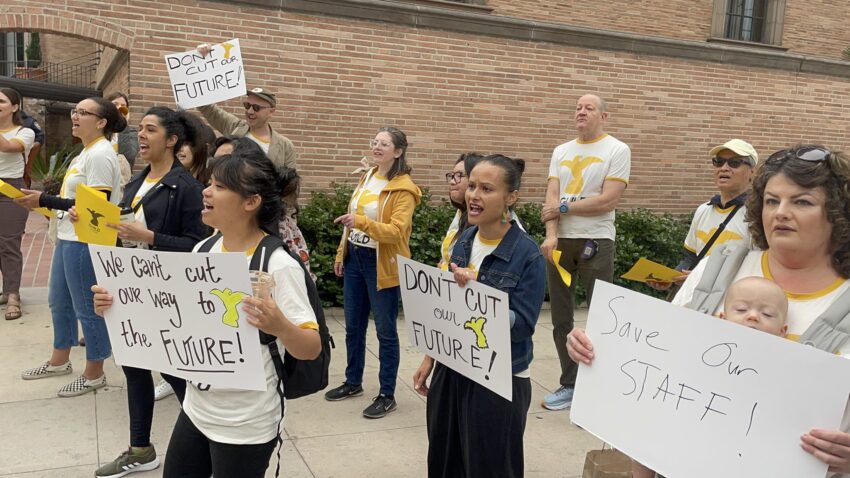
L.A. Times, Guild Negotiating 56 Proposed Layoffs
“The Los Angeles Times Guild bargaining committee told union members Monday that it was still negotiating with the company over 56 proposed layoffs, which primarily affect the paper’s digital editors,” the Poynter Institute reported Wednesday.
“The company stunned staff members when it first announced the layoffs last week. Executive editor Kevin Merida told newsroom employees that the cuts were a response to ‘persistent economic headwinds.’ In the union’s update to members, the bargaining committee shared that it had received a confidential briefing about the Los Angeles Times’ finances.
“ ‘We can’t disclose the details, but suffice it to say that the company is facing strong economic headwinds,’ the committee wrote.
“As proposed by the company, the layoffs will include all six of the union’s audio producers as well as 35 of the union’s 61 multiplatform editors. The latter group includes copy editors; audience engagement editors; and news desk editors, who manage the paper’s homepage and news alerts.
“Multiplatform editors make up one of the most diverse groups of journalists within the union. The Guild shared a layoff analysis with members Monday that found that the cuts would disproportionately affect Asian American and Latino staff.
“ ‘The company wants to blame the contract’s seniority protections for the disparate impact on people of color, without acknowledging that it had many other options — including working with the Guild to develop a more equitable plan, first offering newsroom-wide buyouts, and cutting the growing ranks of upper management,’ the bargaining committee wrote in its update.
“Los Angeles Times spokesperson Hillary Manning wrote in an email that the cuts affect comparable percentages of union and nonunion members and include members of senior management. She added that the union’s contract states that people who were hired most recently will be the first to be laid off, and recent hires have been more diverse than those made in the past.
“ ‘These changes have slowed our momentum in diversifying our newsroom, but we remain committed to diversity and inclusion as core values of our organization,’ Manning wrote. . . .”
Columnist Says Trump Case Highlights Inequities
“When Donald Trump was federally indicted on 37 counts related to allegations of willfully mishandling classified information, he entered a not guilty plea, as was his right. But in my view, Trump has no intention of relying on the same rights that are afforded to every American. He wants a new set of rights for himself,” Solomon Jones (pictured, below) wrote Wednesday for the Philadelphia Inquirer.
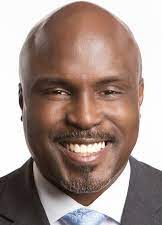 “That’s what tyrants do. They twist and manipulate systems to their own ends, even as they claim that they are working on the people’s behalf. When Donald Trump is done maligning the special prosecutor and the Justice Department, American jurisprudence, which was already hopelessly tilted toward the interests of the rich, will be a mere shadow of itself.
“That’s what tyrants do. They twist and manipulate systems to their own ends, even as they claim that they are working on the people’s behalf. When Donald Trump is done maligning the special prosecutor and the Justice Department, American jurisprudence, which was already hopelessly tilted toward the interests of the rich, will be a mere shadow of itself.
“That should scare every American, but most of all, it should frighten those who are already at the low end of the totem pole. In a justice system where outcomes are often determined by one’s ability to pay for the best lawyers, people of color and the poor are at a disadvantage. Trump’s prosecution — whether or not he is convicted — will not only underline the current inequities. It will make them worse.
“The fact that Trump has already been handled with a level of care that is unavailable to even the most well-heeled defendants has widened the disparities in the justice system. I know this because I have never seen a person of color or a person in poverty who was arrested without being made to pose for a mugshot. It simply does not happen.
“And yet, in the previous two months, we have seen a former president arraigned twice without ever being photographed, handcuffed, or manhandled. We have seen the justice system create a new category of treatment reserved especially for Donald Trump.
“Here is a man who is alleged to have endangered all of us by taking classified documents, refusing to return them, lying about their whereabouts, showing them to unauthorized people, and conspiring to cover up his actions. Yet he is treated with kid gloves.
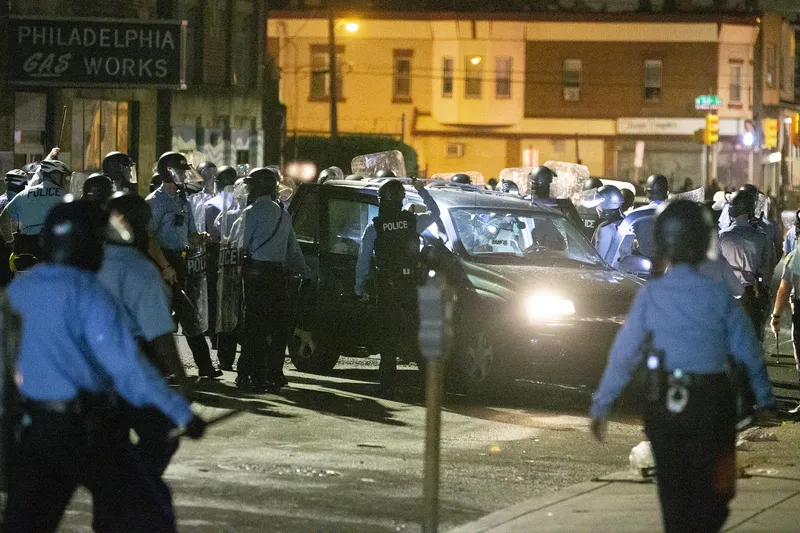
“Meanwhile in Philadelphia, a Black woman named Rickia Young, who committed no crime and endangered no one, was dragged from her car and allegedly beaten by police for mistakenly driving through a protest.
“The only officer charged in that incident was acquitted, and while the city reached a $2 million settlement with Young, no individual law enforcement officials were ever held liable for their actions. I fear that the lack of accountability will be the only thing Black folks will recognize in the case against the former president. . . .”
In the Los Angeles Times, LZ Granderson faulted the news media for its coverage of Trump over the years.
“Back in 1991, two years after he suggested that Black and brown children should be executed for a crime they didn’t commit, Trump was quoted as saying in reference to a Black accountant at one of his casinos: ‘Black guys counting my money! I hate it. The only kind of people I want counting my money are short guys that wear yarmulkes every day.’
“And yet in 2011, executives allowed Trump to appear on ‘The View,’ the ‘Today’ show and ‘Morning Joe’ to question the legitimacy of the country’s first Black president as if one had nothing to do with other.
“He was good on TV, so Trump — who had coined the phrase ‘truthful hyperbole’ decades before — didn’t have to produce any evidence. Just ratings and clicks.
“The nonstop coverage of his 2016 campaign sometimes featured an empty podium as media executives banked on the mere expectation that he would appear. Trump understood all of this. He also understood that millions of Americans felt voiceless. So he leveraged his celebrity to speak on their behalf with the help of an industry he understood how to manipulate all too well. . . .”
- Radley Balko, Daily Beast: Ron DeSantis Wants You to Be Scared Senseless About Crime (Don’t Be) (June 6)
- Wayne Bennett, Field Negro: Charged!
- Wayne Bennett, Field Negro: Tim Scott does not want to be defined by his blackness. His party will do it for him. (June 6)
- Hayes Brown, MSNBC: Trump keeps acting like he didn’t start this
- Stephen L. Carter, Bloomberg News: How Trump’s indictment compares to other espionage act cases
- Renée Graham, Boston Globe: Impeachments, insurrection, indictments — and indifference from Trump’s follower
- Emil Guillermo, Asian American Legal Defense and Education Fund: The Trump Indictments – Where Do You Stand on the Waltine Nauta Scale
- Ruben Navarrette Jr., Washington Post Writers Group: What I like and dislike about Sen. Tim Scott’s vision
- Ruben Navarrette Jr., Washington Post Writers Group: Haley could make the GOP human again
- Eugene Robinson, Washington Post: Arguments against prosecuting Trump don’t add up
- Ben Smith, New York Times: Jeff Zucker Helped Create Donald Trump. That Show May Be Ending. (Sept. 20, 2020, updated Feb. 4, 2021)
- Kimberly Atkins Stohr, Boston Globe: To lawyers, Trump is a kryptonite client — And that’s how he may learn he isn’t above the law.
(more to come)
To subscribe at no cost, please send an email to journal-isms+subscribe@groups.io and say who you are.
Facebook users: “Like” “Richard Prince’s Journal-isms” on Facebook.
Follow Richard Prince on Twitter @princeeditor
Richard Prince’s Journal-isms originates from Washington. It began in print before most of us knew what the internet was, and it would like to be referred to as a “column.” Any views expressed in the column are those of the person or organization quoted and not those of any other entity. Send tips, comments and concerns to Richard Prince at journal-isms+owner@
View previous columns (after Feb. 13, 2016).
View previous columns (before Feb. 13, 2016)
- Diversity’s Greatest Hits, 2018 (Jan. 4, 2019)
- Book Notes: Is Taking a Knee Really All That? (Dec. 20, 2018)
- Book Notes: Challenging ’45’ and Proudly Telling the Story (Dec. 18, 2018)
- Book Notes: Get Down With the Legends! (Dec. 11, 2018)
- Journalist Richard Prince w/Joe Madison (Sirius XM, April 18, 2018) (podcast)
- Richard Prince (journalist) (Wikipedia entry)
- February 2018 Podcast: Richard “Dick” Prince on the need for newsroom diversity (Gabriel Greschler, Student Press Law Center, Feb. 26, 2018)
- Diversity’s Greatest Hits, 2017 — Where Will They Take Us in the Year Ahead?
- Book Notes: Best Sellers, Uncovered Treasures, Overlooked History (Dec. 19, 2017)
- An advocate for diversity in the media is still pressing for representation, (Courtland Milloy, Washington Post, Nov. 28, 2017)
- Morgan Global Journalism Review: Journal-isms Journeys On (Aug. 31, 2017)
- Diversity’s Greatest Hits, 2016
- Book Notes: 16 Writers Dish About ‘Chelle,’ the First Lady
- Book Notes: From Coretta to Barack, and in Search of the Godfather
- Journal-isms’ Richard Prince Wants Your Ideas (FishbowlDC, Feb. 26, 2016)
- “JOURNAL-ISMS” IS LATEST TO BEAR BRUNT OF INDUSTRY’S ECONOMIC WOES (Feb. 19, 2016)
- Richard Prince with Charlayne Hunter-Gault, “PBS NewsHour,” “What stagnant diversity means for America’s newsrooms” (Dec. 15, 2015)
- Book Notes: Journalists Follow Their Passions
- Book Notes: Journalists Who Rocked Their World
- Book Notes: Hands Up! Read This!
- Book Notes: New Cosby Bio Looks Like a Best-Seller
- Journo-diversity advocate turns attention to Ezra Klein project (Erik Wemple, Washington Post, March 5, 2014)

